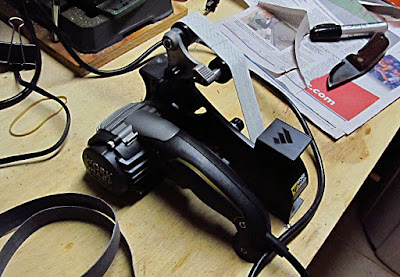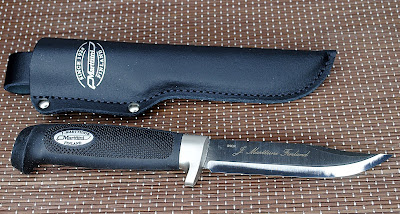 |
| Marttiini Explorer: It said so on the blade |
There
is a universe of quality knives that are largely unknown to the American buying
public. One such is the Marttiini
brand. So when I saw the brown leather
sheath stamped ‘Marttiini’ among the rest, I knew what to grab. Their motto is “Created by Artic Evolution”
and in that harsh unforgiving environment your knife may be the difference between
surviving or dying. Pick your tools wisely
young Jedi. Marttiini knives are still
manufactured at the Arctic Circle.
 |
| The sheath, especial the closing flap is a little chewed up |
The Marttiini Story
Janne Marttiini was born on May 2nd, 1893 in the small village of Kierinki. It is a harsh environment of short summers and long, cold winters on mountain ranges older than life. In 1928 Janne founded J. Marttiini’s Knife Factory Ltd. on Vartiokatu Street in Rovaniemi. With the knife user in mind, he began to create beautiful, high quality knives to exceed the harshest conditions imaginable.
He sold his knives throughout the region and their sales created prosperity and opportunity. As demand for his knives grew Janne hired more and more people and the number of employees grew steadily. There was worldwide demand for high quality knives, and Marttiini exports grew driven by their quality.
Janne’s son, Toivo Marttiini, led the company in the 60s. Toivo’s younger brother, Lauri Marttiini, took the reins of leadership in 1975. In 2001 Mrs. Päivi Ohvo, was appointed to the office of CEO. In 2005, Marttiini’s family sold the entire capital stock of Marttiini Ltd. to Rapala VMC Corporation. And throughout that time quality knives rolled off the production lines and most of us are unaware of it.
My Marttiini
So what knife did I have? The blade is vibro etched by hand with INOX - Explorer Knife - Made by Marttiini – Finland. I could find images, but not much more. Fortunately the internet came to my rescue.
Janne Marttiini was born on May 2nd, 1893 in the small village of Kierinki. It is a harsh environment of short summers and long, cold winters on mountain ranges older than life. In 1928 Janne founded J. Marttiini’s Knife Factory Ltd. on Vartiokatu Street in Rovaniemi. With the knife user in mind, he began to create beautiful, high quality knives to exceed the harshest conditions imaginable.
He sold his knives throughout the region and their sales created prosperity and opportunity. As demand for his knives grew Janne hired more and more people and the number of employees grew steadily. There was worldwide demand for high quality knives, and Marttiini exports grew driven by their quality.
Janne’s son, Toivo Marttiini, led the company in the 60s. Toivo’s younger brother, Lauri Marttiini, took the reins of leadership in 1975. In 2001 Mrs. Päivi Ohvo, was appointed to the office of CEO. In 2005, Marttiini’s family sold the entire capital stock of Marttiini Ltd. to Rapala VMC Corporation. And throughout that time quality knives rolled off the production lines and most of us are unaware of it.
My Marttiini
So what knife did I have? The blade is vibro etched by hand with INOX - Explorer Knife - Made by Marttiini – Finland. I could find images, but not much more. Fortunately the internet came to my rescue.
Hanna
Helin at Marttiini answered my e-mail and provided the information I was searching
for. Thanks Hanna!
The
Explorer was a line of knives with different blade lengths, 7, 9.5 and 11.5
centimeters. That would be about 2.75,
3.7 and 4.3 inches long. The handle is
rosewood. The blade is simply identified
as a stainless chrome steel. The knives
were manufactured from the 1980s to their demise in 1996. Mine is the smallest blade, 2.75 inches with
a rosewood handle.
All
stainless steel contains chromium.
Chromium forms a semi-flexible, transparent oxide film that prevents
rusting. Excess chromium reacts with the
carbon in steel to form very hard and very tiny chromium carbides. These carbides, despite their name are closer
to ceramics in structure and give steel many of its go-to properties.
The
knife and its sheath have seen some rough handling. I didn’t want to give the knife a complete
make-over. While it is a popular
descriptive phrase and it makes me laugh, both the knife and sheath have a patina
of use I wanted.
The
leather sheath needed a cleaning so a mild hand soap and terry cloth rag
cleaned the leather and I let it air dry.
I followed it by a polishing with a brown wax polish and buffed the
leather. It still has the stains and
burn marks but it looks better.
 |
| I like the pressed designs in the leather. The sheath has a pressed composited slipped down in the blade area to keep the edge from cutting through and biting you. |
I had previously purchased a sharpening gauge to determine the sharpening angle of blades and put it to work.
 |
| And it opens beer bottles too!! |
The best
match, I found, was at 20 degrees. I
found an open spot on the garage work bench and set up my Ken Onion Work Sharp
Sharpener. So what grit belt should I
use?
After
an initial run on a worn out medium grit belt I selected three grades, coarse,
medium and fine. Then I got out my
secret sharpening weapon: a black magic marker.
 |
| You can see the Explorer on newspaper next to my secret weapon, the black magic marker |
If
you don’t use one I recommend it. Just
color the edge you’re sharpening and each pass will tell you if you are
accomplishing what you want. Clean the
residue off the blade with a little shop acetone or nail polish remover.
It
took about six passes with the coarse before I had a wire edge on one side of
the knife and six on the other to remove it and create a new one. By following with the medium and fine I
walked the edge over to the sharpness I wanted.
I stropped with several sheets of newspaper on a flat surface and it was
sharp!
I
thought about using some 1000 grit wet-dry paper to knock down the rosewood
handle finish and reseal with linseed oil, but I elected to stay, at least for
the time being, with the original finish on the grip.
 |
| Yes, the polished sheath does still show the patina of wear and use. I don't know, I find it strangely honest and what I want in any knife is honesty. |
https://www.knifecenter.com/item/MN17/marttiini-bowie-fixed-plain-blade-zytel-handles-leather-sheath
Unfortunately
this knife isn’t available, but others are.
I like their Bowie Condor, another totally icey Marttiini knife. The black leather sheath has a plastic liner
to reduce stab through and protect you if you fall in the field. The knife sits deep in the sheath preventing accidental
pull-out by clothing or grabby summer weeds.
The belt loop sports what I think is a button slit, but I have never
been able to confirm it. I suspect a
button sewn just behind your hip, so the belt passes over it would secure your
knife in the same place. The button
holds the knife in the same place and the belt secures it to you. Then when you are searching for the knife
under your arctic parka or under multiple layers of wool, fleece and water-proofed
canvas you know exactly where the knife is.
 |
| I've gotten some very nice reports from users in the field for ease of handling and sharpness combined with edge retention. |
In
any case I really like my Marttiini and recommend it.








